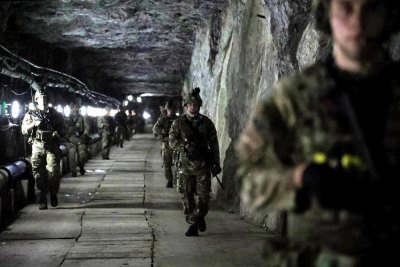
Normally confined to the ammunition depot at Coulport on Loch Long or the berths at nearby Clyde Naval Base used by the Royal Navy’s Vanguard-class submarines when not on deterrent patrol or training, 43 Commando Fleet Protection Group Royal Marines are the last line of defence protecting the nation’s Trident missiles and the machines which carry them.
The unit trains daily, but also conducts extended exercises, playing out various scenarios to keep them on their toes – usually in their native Scotland.
This year, however, the marines of O and P Squadrons swapped Gareloch for Gibraltar to master close-quarters battle – and to expose them to a fresh, challenging and unfamiliar environment.
THE ROCK PRESENTS NEW CHALLENGES
The Rock presents the Royal Marines with physical challenges in the form of arid, rugged terrain – it’s still mostly dry and dusty with temperatures reaching the low 20s at this time of year – as well as its numerous caves and wartime tunnels, says the Royal Navy.
And add: All of which takes the commandos out of their ‘comfort zone’ and allows them to hone close quarter battle skills and practice securing critical infrastructure in a fresh, challenging and unfamiliar environment.
Weather and terrain aside, Gibraltar surprisingly closely mirrors the complex environment in which the marines work at their Clyde base.
Both are comprised of jetties set in a busy industrial and maritime setting with complex infrastructure.
The main phase of the Rock training – Exercise Serpent Rock 19 – involved moving at night through a series of underground tunnels before emerging in empty streets of Gibraltar and towards their first objectives around the jetties.
ALL-NIGHT TRAINING
With complete surprise achieved – and the rest of Gibraltar still asleep – the marines overcame strong resistance from a well-trained enemy and reached their goal before the first rays of light touched the Rock.
Gibraltar is one of a number of overseas training areas that 43 Commando uses to keep its marines at a high level of readiness for its role back in Scotland, said Major Dan Sawyers, Officer Commanding P Squadron.
They didn’t stop there, however. With little time to rest the 43 men moved quickly on to their next task: securing a mock village with its array of complex tunnels.
GIBRALTAR'S ILLUSTRIOUS HISTORY
When the ‘fighting’ was over, the Clyde-based Commandos were reminded of their Corps’ illustrious history with a tour of Gibraltar – the Rock is the only battle honour to be named on the Corps heraldic crest, the Globe and Laurel. They also learned about the key role the tunnels and secret complexes hidden in the mountain played during World War 2.
And no visit to Gibraltar would be complete without a ‘Rock Run’ – from the naval base to the top of the 1,300ft mountain which dominates the small territory.
“Making use of Gibraltar’s training facilities – in particular its working dockyard and tunnel system, which require marines to adopt a whole variety of traditional and novel approaches – allows us to put our personnel under considerable psychological and physical stress in an unfamiliar environment.
“In the maritime-industrial environment, where in the space of just a 100 metres you can encounter a constantly changing landscape, marines were continuously forced to identify and quickly change their tactics to deal with any threats they face.”
NUCLEAR DETERRENT PUT TO TEST
Major Sawyer believes not just the safety and security of the nuclear deterrent will benefit from the skills, tactics and experience of the stint in Gibraltar, but the wider corps.
“And for many of our marines this was their first time experiencing the Rock and learning about its place in our history. Gibraltar holds a significant place in our corps’ heritage,” said Major Dan Sawyers, Officer Commanding P Squadron.
31-10-2019 PANORAMAdailyGIBRALTAR